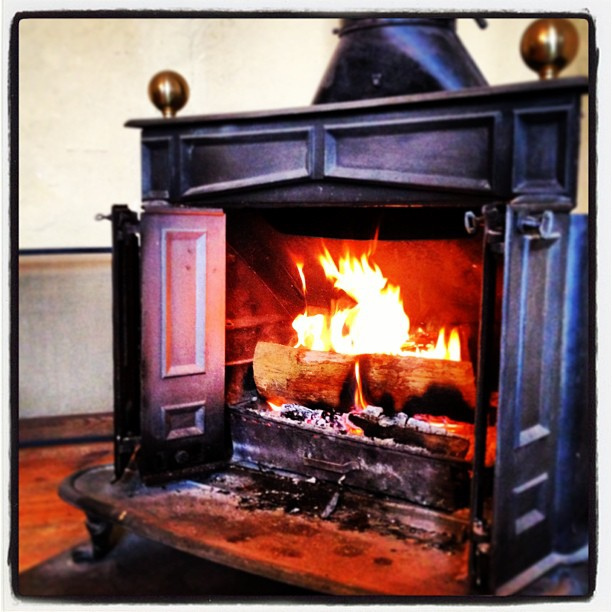The Benjamin Franklin stove stands as a testament to innovation and practicality in early American history. Developed during the frigid winters of the Little Ice Age, this ingenious invention was not merely a means to warm homes but a significant leap in climate adaptation technology. Franklin’s creation enabled households to maximize warmth while minimizing wood consumption, addressing the pressing need for efficient heating amid rising population and dwindling firewood supplies. Historian Joyce Chaplin emphasizes how this stove, often overlooked compared to Franklin’s more famous inventions like the lightning rod, contributed to advancements in atmospheric science by fostering understanding of heat distribution and air movement. In her recent work, “The Franklin Stove: An Unintended American Revolution,” Chaplin explores how this modest device impacted perceptions of weather, technology, and ultimately, human comfort in an era of climate extremes.
Also recognized as a vital improvement in heating systems, the Franklin fireplace was designed to enhance indoor comfort while addressing contemporary environmental challenges. This invention not only illustrated Franklin’s innovative spirit but also played a key role in mapping the intricate relationship between heat and atmospheric conditions—an early nod to more comprehensive studies in atmospheric science. By merging technology with the knowledge of climate adaptation, Franklin opened doors to discussions that would shape future scientific inquiry. His lesser-known contributions remind us that the pursuit of knowledge often begins with simple solutions to complex problems, echoing themes of environmental responsibility highlighted by scholars like Joyce Chaplin. As the discourse around energy efficiency and climate change continues, Franklin’s legacy urges modern thinkers to embrace a multifaceted approach to innovation.
The Franklin Stove: An Innovative Climate Adaptation
The Franklin stove, often overshadowed by Franklin’s more famous inventions, represents a significant advancement in home heating technology. Developed during the harsh winter of 1740-41, this stove was designed to greatly improve heating efficiency while consuming less wood. Joyce Chaplin argues that this creation not only helped individuals adapt to climatic changes but also showcased Franklin’s innovative approach to problem-solving during an era marked by extreme weather conditions. The stove’s design reflected a deep understanding of thermal dynamics, which contributed to the broader discourse on energy conservation and climate adaptation in the face of brutal winters.
Franklin’s ingenuity can be seen as an early attempt to address environmental issues through science and technology. By creating a heating solution that required less fuel, Franklin not only improved comfort but also began a conversation about sustainability long before it became a pressing global concern. His investigations into the mechanics of heating and convection laid the groundwork for future atmospheric science, linking his work on the Franklin stove to the understanding of larger ecological systems, such as the Gulf Stream. Chaplin meticulously illustrates how Franklin’s practical inventions stemmed from a profound understanding of the interplay between humanity and nature.
Understanding the Science Behind the Franklin Stove
The Franklin stove is more than just a household appliance; it embodies early principles of atmospheric science. In a time when the concept of ‘atmosphere’ was still being defined, Franklin’s invention was a practical demonstration of convection. By heating air and allowing it to circulate, this stove created a more comfortable indoor environment while simultaneously serving as a model for understanding outdoor meteorological phenomena. This connection between a functional heating system and atmospheric dynamics illustrates Franklin’s foresightedness in applying scientific principles to everyday challenges.
Franklin’s explanation of the stove’s operation, which detailed how warm air rises and cool air descends, also mirrored the natural processes occurring outdoors. He used accessible language to describe these scientific concepts, making them understandable to the general public. This approach not only promoted the use of his stove but also disseminated fundamental principles of science that would later contribute to the field of atmospheric studies, influencing generations of thinkers and scientists. Through the Franklin stove, he effectively bridged the gap between home technology and a growing understanding of environmental science.
Benjamin Franklin’s Lesser-Known Inventions and Their Impact
While many people recognize Franklin’s inventions like the lightning rod and bifocals, his stove often remains in the shadows. Joyce Chaplin’s research highlights the multifaceted nature of Franklin’s contributions to science and society. By focusing on the Franklin stove, Chaplin aims to shift public perception and enhance appreciation for this lesser-known innovation. The design principles of the stove include not only improvements in heating efficiency but also a deep concern for environmental impact, illustrating Franklin’s holistic approach to invention.
The initiative Franklin took to modify the conventional fireplace into a more efficient heating source speaks volumes about his inventive spirit. This transformation was particularly relevant in an era when energy resources were becoming scarce and environmental costs of heating became apparent. Thus, the Franklin stove represents a pivotal moment in the history of American innovation where practical solutions to everyday problems intertwined with a new awareness of environmental stewardship. Franklin’s inventions were not merely tools; they were integral parts of the evolving relationship between humanity and nature.
The Role of Franklin’s Stove in Outdoor Atmospheric Phenomena
Chaplin emphasizes that the Franklin stove is deeply connected to the evolution of atmospheric science, particularly in understanding wind and weather patterns. Franklin’s interest in atmospheric dynamics was piqued as he studied how the stove functioned in heating environments. His insights into how heat rises and creates airflow helped him elucidate larger phenomena, such as storm movements along the Atlantic coast and the Gulf Stream’s behavior—critical components of early meteorological studies. This connection demonstrates that the pursuit of innovation often leads to unexpected scientific breakthroughs.
Franklin’s work not only paved the way for future understanding of meteorology but also prefigured modern concerns about climate and environmental management. By improving home heating efficiency and reducing fuel needs, the Franklin stove contributed to a more profound understanding of human impact on the environment. Chaplin’s portrayal of Franklin’s inventions reveals a commitment to harnessing technology for the betterment of society, reinforcing the idea that scientific inquiry and practical invention are intricately linked.
Franklin’s Influence on Sustainable Practices and Technology
The transition from wood-burning fireplaces to the Franklin stove symbolizes a significant shift toward sustainability in energy consumption during the 18th century. This innovation came with Franklin’s deep-seated awareness of the environmental implications of using natural resources. His quest for developing a stove that burned wood efficiently was, in essence, an early venture into sustainable practices long before modern environmentalism was a recognized field. Chaplin argues that Franklin’s foresight in seeking alternatives to traditional heating methods reflects a broader enlightenment confidence in human ingenuity to craft practical solutions to ecological challenges.
Moreover, Franklin’s commitment to reducing emissions from his stove echoed the contemporary discourse on air quality and climate action. By attempting to minimize smoke and enhance combustion efficiency, he set a precedent that aligns with today’s scrutiny of emissions and environmental impact. As we grapple with the climate crisis, Franklin’s spirit of innovation and his conscience about ecological responsibility remain relevant, urging modern inventors and policymakers to pursue multifaceted solutions that prioritize sustainability alongside technological advancement.
Reviving Interest in Franklin’s Scientific Contributions
Historian Joyce Chaplin’s exploration of the Franklin stove aims to rekindle interest in Benjamin Franklin’s scientific contributions beyond the commonly known inventions. By showcasing the stove as a critical instrument for understanding climate adaptation and atmospheric science, Chaplin invites readers to appreciate Franklin’s role in the larger narrative of American innovation. The discussions surrounding the stove provide valuable context for current debates on energy efficiency and environmental responsibility, transcending the bounds of its time.
Additionally, by connecting Franklin’s legacy with modern environmental issues, Chaplin highlights the importance of historical context in our understanding of technological advancement. His multifaceted approach to innovation encourages a holistic view where science, technology, and citizenship converge. This renewed interest in Franklin not only enriches our understanding of early American history but also inspires contemporary society to reflect on our relationship with technology and the environment.
Lessons from Franklin’s Era for Today’s Climate Challenges
Franklin’s inventive spirit offers vital lessons as we confront today’s climate challenges. His proactive approach in developing the Franklin stove illustrates the power of creativity and science as tools for addressing pressing societal needs. As Chaplin points out, Franklin’s work exemplifies the belief that technology can facilitate positive change, even amid environmental crises. Emphasizing adaptability and foresight, Franklin’s legacy encourages modern innovators to think critically about how their creations impact the world around them.
Moreover, Franklin’s endeavors remind us that solving the climate crisis requires collaboration and diverse solutions. Just as Franklin did not rely on a singular invention to make a difference, contemporary society must embrace a multifaceted strategy that integrates various technologies and practices. His narrative serves as a call to action, urging us to harness the spirit of Enlightenment thinking to navigate the complexities of climate adaptation and to strive for a sustainable future.
Exploring Franklin’s Legacy through Atlantic Science
Benjamin Franklin’s contributions extend far into the realm of Atlantic science, particularly concerning his work on mapping the Gulf Stream. By connecting his inventions, such as the Franklin stove, with broader scientific inquiries, Chaplin illustrates the interconnectedness of Franklin’s legacy with maritime and atmospheric studies. This broader context reveals the intellectual environment of the 18th century, where scientific exploration was deeply tied to practical inventions that sought to improve everyday life.
Franklin’s dedication to understanding currents and winds reflects an early intersection of scientific inquiry and practical application, much like the energy efficiency he aimed to achieve with his stove. Such innovations not only enhanced the comfort of domestic life in his era but also informed critical knowledge about navigation, weather patterns, and environmental interactions across the Atlantic. Chaplin’s scholarship ultimately sheds light on how Franklin’s legacy continues to resonate in both historical and modern scientific discourse.
Franklin’s Vision of an Interconnected World
Franklin’s inventions, including the Franklin stove, embody a vision of an interconnected world where technology serves to not only enhance individual lives but also address common challenges. Through the lens of Joyce Chaplin’s analysis, we see how Franklin viewed human ingenuity as a means to reconcile conflicts between society and the natural environment. His approach to invention was not just about practicality; it was also about fostering a scientific understanding that links technological advancements with the health of the planet.
This perspective is particularly relevant today as we delve into discussions surrounding climate change and sustainability. Franklin’s ability to adapt to changing circumstances through innovative thinking serves as a model for contemporary society, urging us to consider not only how we utilize technology but also the broader implications of our actions on global ecosystems. Emphasizing interconnectedness, Franklin’s legacy challenges us to adopt a comprehensive approach to solving the pressing issues of our time.
Frequently Asked Questions
What was the purpose of Benjamin Franklin’s stove invention?
The Benjamin Franklin stove was designed to improve heating efficiency compared to traditional fireplaces, allowing for greater warmth while using less wood. It served as a climate adaptation during the colder winters of the early 18th century, showcasing Franklin’s innovative approach to technology and comfort in the face of severe weather.
How did Benjamin Franklin contribute to atmospheric science with his stove?
Franklin’s stove advanced atmospheric science by utilizing the principle of convection, which he explained in relation to how warm air rises. This concept helped him illustrate how storm systems move and eventually contributed to understanding the Gulf Stream, highlighting the interconnectedness of indoor heating and outdoor atmospheric phenomena.
Why is Joyce Chaplin’s book about Benjamin Franklin’s stove significant?
Joyce Chaplin’s book, ‘The Franklin Stove: An Unintended American Revolution,’ highlights the stove as a central invention in Franklin’s legacy, linking it to his scientific contributions. It emphasizes how Franklin’s climate adaptation efforts with the stove influenced thinking about technology, comfort, and environmental awareness in the context of historical and contemporary climate challenges.
What were the environmental concerns that led Franklin to create his stove?
During the harsh winter of 1740-1741, Franklin recognized that increased deforestation due to settlement was making firewood scarce, particularly for poorer populations. His stove design aimed to address these environmental concerns by using less wood while ensuring greater warmth, reflecting his understanding of climate adaptation.
How does the Franklin stove relate to modern climate adaptation strategies?
The Franklin stove exemplifies early attempts at climate adaptation through innovative technology, illustrating how inventions can address environmental challenges. In today’s context, it serves as a reminder that multiple solutions are needed to address climate change, echoing Franklin’s belief in using ingenuity to improve human comfort and health.
What materials did Franklin use for his stove, and how did it evolve over time?
Benjamin Franklin initially designed the stove to burn wood efficiently, but over time, he developed several iterations that later included coal as a fuel source. This evolution showcases his adaptability and understanding of available resources while aiming to minimize emissions and enhance heating efficiency.
What did Benjamin Franklin’s attempts to minimize emissions reveal about his views on air quality?
Franklin was deeply concerned about air quality, particularly in polluted cities like London. His later stove versions were designed to recycle smoke and reduce airborne pollutants, indicating an early awareness of environmental health and the need for cleaner energy solutions.
How does the Franklin stove contribute to the appreciation of Franklin’s multifaceted legacy?
The Franklin stove adds a lesser-known yet impactful dimension to Benjamin Franklin’s legacy, illustrating his role as a inventor and scientist who sought to improve daily life through technology. It challenges the popular image of him as merely a political figure, revealing his significant contributions to science and environmental awareness.
| Key Points |
|---|
| The Benjamin Franklin stove was developed as a response to the harsh winter of 1740-1741 to improve heating efficiency and comfort. |
| It utilized the principles of convection to effectively warm indoor spaces and contributed to understanding atmospheric phenomena. |
| Franklin designed the stove to minimize smoke emissions and improve air quality, showcasing early concerns about pollution. |
| Chaplin’s book highlights Franklin’s influence on modern thinking about technology, climate adaptation, and comfort. |
Summary
The Benjamin Franklin stove stands out as a remarkable invention that transcended its primary function of heating. Developed during a particularly cold period, it showcased Franklin’s innovative approach to warming spaces more efficiently while minimizing wood consumption. This invention not only provided relief during the Little Ice Age but also influenced scientific discourse on atmospheric phenomena. By applying his understanding of convection, Franklin significantly advanced both practical heating solutions and theoretical meteorology. The ongoing relevance of the Benjamin Franklin stove in discussions about technology and climate adaptation underlines its importance as a tool for improving human life and a historical lesson in our continuous quest for better solutions to environmental challenges.



